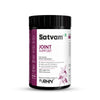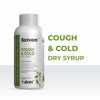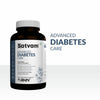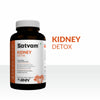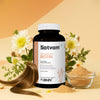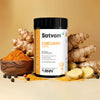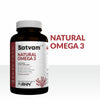In this health-conscious world, most of us would have heard of the term 'Essential Fatty Acids.' The interest in health and wellness is rising, with more people gravitating towards leading a healthy life. For instance, the McKinsey 2022 report says that around 50% of people in the US prefer wellness as one of their everyday top priorities, a considerable rise from 42% in 2020. This trend is not limited to the US alone. The global wellness economy now represents 5.6% of the global economic output, with a projected growth rate of around 7 trillion US dollars by 2025.
However, most of our society has the common misconception that staying healthy is akin to losing weight and that the key to weight loss is having a 'High-protein, low-fat' or 'High-Protein, No-fat' food. While weight loss is a significant part of a healthy regime, it does not simply occur through a 'no-fat' diet.
Not all fatty acids are harmful and will make you gain weight. There are certain fats that your body needs for healthy functioning and muscle development. These fats are called 'Essential Fatty Acids (EFAs).'
Getting enough of these EFAs ensures proper cell, nerve, tissue, and organ function. So, in this article, we shall look at the simple science behind these fundamental fats - exploring what they are, why we need them, symptoms of deficiency, and most importantly, the food sources you need to consume to meet your daily needs of the EFAs.
What are Essential Fatty Acids?
Essential fatty acids are polyunsaturated fatty acids (poly: many, unsaturated: double) that the body needs for good health but cannot produce independently. The term ‘essential’ means they must come from the diet.
The two major classes of Polyunsaturated Fatty Acids (PUFAs) are
- Omega-3 Fatty Acids
- Omega-6 Fatty Acids
Omega-3 fatty acids
The most well-known omega-3s are:
-
Alpha-linoleic acid (ALA) - Found in plant foods like flaxseeds, chia seeds, and walnuts
- Eicosapentaenoic acid (EPA) and Docosahexaenoic acid (DHA) - primarily found in seafood like salmon and trout
Omega-9 fatty acids are necessary but not essential since the body can produce enough of these acids once the EFAs are adequately present.
Omega-6 Fatty Acids
The most common omega-6 is linoleic acid. It is abundant in seeds, nuts, and vegetable oils like sunflower, corn, cottonseed, and soybean oils. Another form of linoleic acid, conjugated linoleic acid (CLA), is not considered essential because your body can produce the required CLA.
Why Are EFAs So Important?
EFAs produce hormone-like substances that help in these processes
- Lowering blood pressure and inflammation
- Maintaining healthy blood triglyceride levels
- Aiding in muscle contraction/relaxation.
- Helping to maintain the condition of the skin
They are also needed to form cell membranes throughout the body. So, without them, cells cannot function properly.
Additionally, these healthy fats support:
- Brain function [DHA omega-3]: critical for memory, learning, and mood
- Healthy vision [DHA is a major structural component of your eye's retina]
- Strong immunity: regulating chronic inflammation to prevent disease
In short, no other nutrients do more to support overall cell and tissue integrity throughout the whole body.
Omega-3 and Omega-6 fatty acids are unsung heroes for our well-being. Imagine them as the dynamic duo supporting your body's daily functions.
Omega-3s are the brain's best friends, ensuring it stays sharp and agile. On the other hand, Omega-6s, abundant in nuts, seeds, and oils, act as the body's defenders, tackling inflammation and maintaining healthy blood pressure. Having high omega-3 foods can help you to lead a healthy life.
Signs and Symptoms of EFA Deficiency
Now that we have understood what the EFAs are and how they help our body, we need to understand some of the common symptoms of EFA deficiency:
- Dry, scaly skin, stretch marks and premature wrinkles
-
Dry eyes, mouth or throat
- Stiffness in the joints
- Changes in hair texture
- Depression
- Allergies, asthma, hives or eczema
Getting enough Essential Fatty Acids through your diet ensures a healthy body. It also allows you to reap their health-promoting effects.
Sources of Omega-3 fatty acids

This section will examine the list of foods high in Omega-3 fatty acids.
Alpha Linoleic Acid:
- Flaxseed and flaxseed oil
- Canola oil
- Walnuts
- Soybeans
- Pumpkin seeds
EPA/DHA Seafood Sources:
- Salmon
- Sardines
- Anchovies
- Rainbow trout
- Atlantic mackerel
- Pacific oysters
If you cannot obtain omega-3 fatty acids from seafood, you can consider taking omega-3 fish oil capsules. Omega-3 fish oils are extracted from oily fishes like mackerel, herring, tuna, and anchovies. They are enriched with vitamins A and D, apart from omega-3s.
Sources of Omega-6 fatty acids
Some of the omega-6-rich foods include
- Walnuts
- Sunflower Seeds
- Tofu
- Safflower oil
- Eggs
- Avocados
- Almonds
- Cashews
How much of EFAs do you need?
The dietary intake recommendations for the EFAs are developed and provided by the Food and Nutrition Board of the National Academy of Medicine.
Although the official recommended intake of Omega-3 is currently set at 1.6 grams per day for men and 1.1 grams for women, research suggests a higher intake can be advantageous.
Here are the recommended daily intakes of foods high in omega-3 and 6 to support optimal muscle growth, fat loss, and overall health:
Omega-3:
- Men: 3-3.5 grams per day from all sources
- Women: 2.5-3 grams per day from all sources
Omega-6:
- Men: 9-14 grams per day from all sources
- Women: 7.5-12 grams per day from all sources
Focus on getting the Essential Fatty Acids from whole food sources whenever possible, then switch to supplements if needed. The USDA's FoodData Central has a comprehensive list of all the sources with EFAs and their nutrient content.
Choosing the right EFA supplements
Suppose you have decided to switch to EFA supplements to meet your daily requirements of omega 3, 6, and 9. In that case, choosing supplements that provide a balanced proportion of omega-3 and omega-6 is wise.
Therefore, look for a supplement with a 3:1 ratio or higher of omega-3 and omega-6. This ensures you enjoy optimal health.
Omega 3 fish oil, flaxseed oil, grapeseed oil, and other EFA blends make a good choice for supplements. However, some people may prefer something other than these oils due to their smell and taste. Many omega-3 fish oil capsules are available for these people to supplement their dietary intakes. These oils are cost-effective and can be mixed with protein shakes or daily juices. So, it is essential to research what works best for your lifestyle and personal preferences.
Tips to balance your omega-3 and omega-6 intake
Here are some additional tips for you to balance your Essential Fatty Acids intake:
- Include fish in your diet twice a week
- Snack on Walnuts and Almonds every day (or make them a part of your diet)
- Add flaxseeds, pumpkin seeds, and chia seeds to your smoothies or salads
- Opt for olive oil, safflower oil, or flaxseed oil while cooking
- Consider opting for grass-fed meat as they have a higher proportion of EFAs.
- Check the ingredient lists in your processed food before buying.
These tips will help you become more mindful of your food choices and consumption patterns. Being aware of our food intake can keep various health issues at bay.
Omega-9 fatty acids
Omega-9 fatty acids play a crucial role in promoting overall well-being. Unlike Omega-3 and Omega-6, the body can produce Omega-9 independently, but adding them to your diet provides multiple benefits.
Foods rich in Omega-9 are
- Olive oil
- Avocados
- Nuts,
These fatty acids contribute to maintaining a healthy cardiovascular function and better cholesterol levels. Including Omega-9 in your diet complements the effects of essential fatty acids.
Our two cents
Eating foods with Omega-3, Omega-6, and even Omega-9 is good for your health. These healthy fats help your heart, brain, and overall well-being. You can find Omega-3 in fish, Omega-6 in nuts and oils, and Omega-9 in foods like avocados and olive oil. It's about choosing foods that are good for you and fit your taste. Use this guide to start balancing your levels today.
Visit Satvam Nutrition to explore customized diet and supplement recommendations from expert nutritionists. Talk to our health experts to start your holistic wellness journey today.


